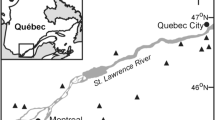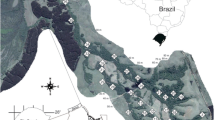Abstract
The interrelationship between river flooding regime, topography, soil properties and the distribution of tree and bamboo species was analysed in an area of tropical semideciduous forest on the margins of the Rio Grande, in Madre de Deus de Minas, Southeastern Brazil. A survey was carried out in a single forest plot (1.597 ha, 71 adjacent 225 m2 quadrats) located in the inner side of a river bend and extending from the point bar to the top of the slope. All trees (≥5 cm diameter at the base of the trunk) and bamboo culms were registered. Soil samples were collected and analysed for their properties and the river level was monitored during a two year period. In the point bar the forest was dominated by only two tree species, Salix humboldtiana and Inga affinis, that tended to occur in distinct areas. Differences in soil properties between these areas suggest variation in sedimentation dynamics. In the sloping part of the plot, a canonical correspondence analysis (CCA) indicated that the floristic composition was significantly correlated with three topographic sectors and their corresponding flood regimes. The Lower Slope corresponds to the sharp transition to the point bar forest, endures partial and annual floods and shows a very distinct flora that includes many light-demanding species. The Middle Slope is only occasionally reached by exceptional river floods and is characterised by a high density of the bamboo Merostachys neesii. The comparatively low density and basal area of trees, particularly for the smaller ones, provide evidence that the bamboos are problably interfering with the trees by restricting their recruitment. The Ridgetop lies entirely above the highest flooding level registered. The density of bamboos is lower and the understorey trees abundant.
Similar content being viewed by others
References
Balslev, H., Luteyn, B., Vllgaard, B. & Holm-Nielsen, L. B. 1987. Composition and structure of adjacent unflooded and flooded forest in Amazonian Ecuador. Opera Bot. 92: 37–57.
Bertoni, J. E. A., Stublebine, W. H., Martins, F. R. & Leitão Filho, H. F. 1982. Nota prévia: comparação fitossociológica das principais espécies de florestas de terra firme e de várzea na Reserva Estadual de Porto Ferreira (SP). Anais do Congresso Nacional de Essências Nativas. Silvic. São Paulo 16A: 563–571.
Bertoni, J. E. A. & Martins, F. R. 1984. Composição floristica de uma floresta ripária na Reserva Estadual de Porto Ferreira (SP). Acta Bot. Brasil. 1: 17–26.
Black, G. A., Dobzhansly, T. H. & Pavan, C. 1950. Some attempts to estimate species diversity and population density of trees in Amazonian forests. Bot. Gaz. 111: 413–425.
Brinson, M. M. 1990. Riverine forests. In: Lugo, A. E., Brinson, M. M. & Brown, S. (eds) Ecosystems of the world 15-Forested wetlands. Elsevier, Amsterdam.
Brower, J. E. & Zar, J. H. 1984. Field and Laboratory Methods for General Ecology. Wm. C. Brown Pub., Dubuque.
Campbell, D. G., Daly, D. C., Prance, G. T. & Maciel, U. N. 1986. Quantitative ecological inventory of terra firme and várzea tropical forest on the Rio Xingu, Brazilian Amazon. Brittonia. 38: 369–393.
Campbell, D. G., Stone, J. L. & Rosas Jr., A. 1992. A comparison of the phytosociology and dynamics of three floodplain (várzea) forests of known ages, Rio Juruá, western Brazilian Amazon. Bot. J. of the Linn. Soc. 108: 213–237.
Causton, D. R. 1988. An introduction to vegetation analysis, principles, practice and interpretation. Unwin Hyman, London.
Corrêa, M. P. 1926. Diccionario das plantas úteis do Brasil e das exóticas cultivadas. v. 4. Imprensa Nacional, Rio de Janeiro.
Eidt, R. C. 1968. The climatology of South America. In: Fittkau, E. J., Illies, J., Klinge, H., Schwabe, G. H. & Sioli, H. (eds). Biogeography and Ecology in South America. v. 1. W. Junk Pub., The Hague.
EMBRAPA 1979. Manual de Métodos de Análises de Solos. Serviço Nacional de Levantamento e Conservação, de Solos, Empresa Brasileira de Pesquisa Agropecuária, Rio de Janeiro.
Felfili, J. M. & Silva Jr., M. C. 1992. Floristic composition phytosociology and comparison of cerrado and gallery forests at Fazenda Água Limpa, Federal District, Brazil. In: Furley, P. A., Proctor, J. & Ratter, J. A. Nature and dynamics of forest-savanna boundaries. Chapman & Hall, London.
Filgueiras, T. S. 1988. A floração dos bambus e seu impacto ecológico. Eugeniana 15: 1–8.
Gavilanes, M. L., Brandão, M., Oliveira-Filho, A T., Almeida, R. J., Mello, J. M. & Avezum, F. F. 1992. Flórula da Reserva Biológica Municipal do Poço Bonito, Lavras, MG. III-formação florestal. Daphne 2: 14–26.
Gandolfi, S. 1991. Estudo floristico e fitossociológico de uma floresta residual na área do Aeroporto Internacional de São Paulo, município de Guarulhos, SP. M. Sc. thesis, Univ. Campinas.
Gibbs, P. & Leitão Filho, H. F. 1978. Floristic composition of an area of gallery forest near Mogi Guaçu, state of São Paulo, S. E. Brazil. Rev. Brasil. Bot. 1: 151–156.
Gibbs, P., Leitão Filho, H. F. & Abbot, R. J. 1980. Application of the point-centred quarter method in a floristic survey of an area of gallery forest at Mogi Guaçu, SP, Brazil. Rev. Brasil. Bot. 3: 17–12.
Hartshorn, G. S. 1990. Gap-phase dynamics and tropical tree species richness. In: Holm-Nielsen, L. B., Nielsen, I. C. & Balslev, H. (eds). Tropical Forests-Botanical Dynamics, Speciation and Diversity. Academic Press, London.
Hitchcock, A. S. 1930. The grasses of Central America. Contr. U. S. Nat. Herb. 24: 552–762.
Hope, A. C. A. 1968. A simplified Monte Carlo significance test procedure. J. Royal Stat. Soc., Ser. B 30: 582–598.
Huberman, M. A. 1959. Bamboo silviculture. Unasylva 13: 36–43.
Junk, W. J. 1990. Flood tolerance and tree distribution in central Amazonian floodplains. In: Holm-Nielsen, L. B., Nielsen, I. C. & Balslev, H. (eds). Tropical Forests—Botanical Dinamics, Speciation and Diversity, 2nd ed. Academic Press, London.
Kalliola, R., Salo, J., Puhakka, M. & Rajasilta, M. 1991a. New site formation and colonizing vegetation in primary succession on the western Amazon floodplains. J. Ecology 79: 877–901.
Kalliola, R., Puhakka, M., Salo, J., Tuornisto, H. & Kalle, R. 1991b. The dynamics, distribution and classification of swamp vegetation in Peruvian Amazonia. Ann. Bot. Fennici 28: 225–239.
Kellman, M. & Tackaberry, R. 1993. Disturbance and tree species coexistence in tropical riparian forest fragments. Global Ecol. Biogeogr. Let. (in press).
MacDougall, A. & Kellman, M. 1992. The understorey light regime and patterns of tree seedlings in tropical riparian forest patches. J. Biogeography 19: 667–675.
McClure, F. A. & Smith, L. B. 1967. Gramineas, Suplemento Bambúseas. In: Reitz, P. R. (ed). Flora Ilustrada Catarinense, 1a parte, Suplemento Graminea. Itajaí.
Mantovani, W., Rossi, L., Romaniuc Neto, S., Assad-Ludewigs, I. Y., Wanderley, M. G. L., Melo, M. M. R. F. & Toledo, C. B. 1989. Estudo fitossociológico de áreas de mata ciliar em Mogi Guaçu, SP, Brasil. In: Barbosa, L. M. (ed). Simpósio sobre mata ciliar, Anais. Fund. Cargill, Campinas.
Oliveira-Filho, A. T. 1989. Composição floristica e estrutura comunitária da floresta de galeria do córrego da Paciência, Cuiabá (MT). Acta Bot. Brasilica 3: 91–112.
Oliveira-Filho, A. T., Ratter, J. A. & Shepherd, G. J. 1990 Floristic composition and community structure of a central Brazilian gallery forest. Flora 184: 103–117.
Oliveira-Filho, A. T., Vilela, E. A., Gavilanes, M. L. & Carvalho, D. A. 1994a. Comparison of the woody flora and soils of six areas of semideciduous montane forest in southern Minas Gerais, Brazil. Edinb. J. Botany (in press).
Oliveira-Filho, A. T., Vilela, E. A., Carvalho, D. A. & Gavilanes, M. L. 1994b. Effect of soils and topography on the distribution of tree species in a tropical riverine forest in Southeastern Brazil. J. Trop. Ecol. (in press).
Pires, J. M. & Koury, H. M. 1958. Estudo de um trecho de mata de várzea próximo de Belém. Bol. Téc. Inst. Agron. Norte. 36: 3–44.
Puhakka, M., Kalliola, R., Rajasilta, M. & Salo, J. 1992. River types, site evolution and successional vegetation patterns in Peruvian Amazonia. J. Biogeography 19: 651–665.
Ratter, J. A. 1980. Notes on the vegetation of Fazenda Água Limpa (Brasília, DF, Brazil). Royal Botanic Garden, Edinburgh.
Renvoize, S. A. 1984. The grasses of Bahia. Royal Botanic Gardens, Kew.
Rodrigues, W. A. 1961. Estudo preliminar de mata de várzea alta de uma ilha do baixo Rio Negro de solo argiloso e úmido. Pub. 10 Inst. Nac. Pesq. Amazonia, Manaus.
Rozza, A. & Ribeiro, C. A. 1992. Estudo florístico e fitossociológico de um fragmento de mata ciliar no campus da ESALQ, Piracicaba, SP. In: VIII Congresso da Sociedade Botânica de São Paulo, Anais.
Soderstrom, T. R. & Calderon, C. E. 1979. A commentary on the bamboos (Poaceae: Bambusoideae). Biotropica 11: 161–172.
Sokal, R. R. & Rohlf, F. J. 1981. Biometry. Freeman, San Francisco.
Swaine, M. D. & Hall 1988. The mosaic theory of forest regeneration and determination of forest composition in Ghana. J. Trop. Ecology 4: 253–269.
Swaine, M. D. & Whitmore, T. C. 1988. On the definition of ecological species groups in tropical rain forests. Vegetatio 75: 81–86.
Ter Braak, C. J. F. 1986. Canonical correspondence analysis: a new eigenvector technique for multivariate direct gradient analysis. Ecology 67: 1167–1179.
Ter Braak, C. J. F. 1987. The analysis of vegetation-environment relationships by canonical correspondence analysis. Vegetatio 69: 69–77.
Ter Braak, C. J. F. 1988. CANOCO—A FORTRAN program for canonical community ordination by (partial) (detrended) (canonical) correspondence analysis, principal components analysis and redundancy analysis Version 2.1. Technical report LWA-88–02, TNO-Inst. Applied Computer Sc., Wageningen.
Veblen, T. T. 1982. Growth patterns of Chusquea bamboos in the understory of Chilean Nothofagus forests and their influences in the forest dynamics. Bull. Torrey Bot. Club. 109: 474–487.
Veblen, T. T. 1985. Stand dynamics in Chilean Nothofagus forests. In: Picket, T. A. & White, P. S. (eds). The ecology of natural disturbance and patch dynamics. Academic Press, New York.
Veblen, T. T., Donoso, C., Schlegel, F. M. & Escobar, B. 1981. Forest dynamics in south-central Chile. J. Biogeography 8: 211–247.
Veloso, H. P., Rangel Filho, A. L. R & Lima, J. C. A. 1991. Classificação da vegetação brasileira adaptada a um sistema universal. Instituto Brasileiro de Geografia e Estatistica (IBGE), Rio de Janeiro.
White, S. 1978. Cedar and mahogany logging in eastern Peru. Geogr. Rev. 68: 394–416.
Whitmore, T. C. 1975. Tropical rain forests of the Far East. Oxford Univ. Press, London.
Whitmore, T. C. 1988. The influence of tree population dynamics on forest species composition. In: Davy, A. J., Hutchings, M. J. & Watkinson, A. R. (eds). Plant population ecology. Blackwell Sc. Pub., Oxford.
Whitmore, T. C. 1990. An introduction to tropical rain forests. OUP, Oxford.
Worbes, M., Klinge, H., Revilla, J. D., Martius, C. 1991. On the dynamics, floristic subdivision and geographical distribution of várzea forests in Central Amazonia. J. Vegetation Sc. 3: 553–564.
Young, K. R. 1991. Natural history of an understory bamboo (Chusquea sp.) in a tropical timberline forest. Biotropica 23: 542–554.
Zar, J. H. 1984. Biostatistical analysis. Prentice-Hall, New Jersey.
Author information
Authors and Affiliations
Rights and permissions
About this article
Cite this article
Oliveira-Filho, A.T., Vilela, E.A., Gavilanes, M.L. et al. Effect of flooding regime and understorey bamboos on the physiognomy and tree species composition of a tropical semideciduous forest in Southeastern Brazil. Vegetatio 113, 99–124 (1994). https://doi.org/10.1007/BF00044229
Accepted:
Issue Date:
DOI: https://doi.org/10.1007/BF00044229




